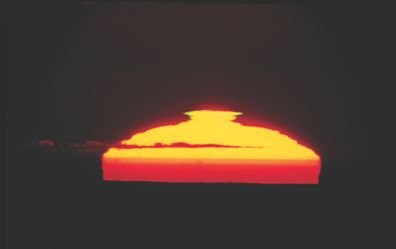 Facebook
Facebook
 X
X
 Instagram
Instagram
 TikTok
TikTok
 Youtube
Youtube

Crystal-clear skies are visiting us again, as Santa Ana winds swoop down intermittently from the northeast, as cold winds blow from the north, or as high pressure invades the county and lingers here for a day or two. This is the best time to try for a sighting of the famed “green flash” of the setting or rising sun. Pacific Beach’s Green Flash Restaurant and Vista’s Green Flash Brewing Company pay homage to this elusive, non-illusory optical effect and its renown among San Diego skywatchers.
The flash itself is sometimes no more than a fleeting glimmer of emerald green on the horizon when only the barest hint of the sun’s upper rim is exposed to view. A complex optical chemistry involving refraction, dispersion, and scattering of sunlight through the atmosphere explains how the various colors of the low-angle sun split into slightly different paths so that observers on the ground see the color green on top. Clouds and any kind of light-absorbing dust or haze tend to mask the phenomenon completely. Beach residents don’t see the green flash as much at sunset as they think they should because there’s often too much fog, haze, or smog above the ocean surface.
On occasion, the mirage-like effects of temperature inversions (warmer air overlying cooler air) over the ocean can cause the setting sun to apparently split into two images, with the upper image shrinking to a green point or line before the lower image disappears on the horizon. That’s another kind of green flash. The effect can appear dramatic when seen in binoculars, provided the observer is situated at the just the right altitude above the ocean.
Sunrise actually offers more opportunity, especially in late fall and winter when the air to the east is dry and clear. Just look east at around 6:35 a.m. (currently) and try to catch the sun clearing a flat, level segment of the mountain profile. The first glimmer of bright light you see may be colored green. Very quickly that spot turns yellow or white, and soon thereafter the gathering sunlight becomes too bright to look at safely or comfortably. I’ve seen green flashes at sunrise over far eastern horizons of Arizona and Sonora, Mexico, from the 6000-foot summits of the Laguna Mountains, east of San Diego.
You can also see the green flash over artificial horizons (as opposed to mountain or ocean horizons) — as long as the setting or rising sun is very low in the sky. On one occasion, while driving westbound on the Martin Luther King Freeway near 25th Street just a few minutes before sunset, I witnessed a quarter-second-long green flash over the flat roof of the Meridian condominium tower downtown.


Crystal-clear skies are visiting us again, as Santa Ana winds swoop down intermittently from the northeast, as cold winds blow from the north, or as high pressure invades the county and lingers here for a day or two. This is the best time to try for a sighting of the famed “green flash” of the setting or rising sun. Pacific Beach’s Green Flash Restaurant and Vista’s Green Flash Brewing Company pay homage to this elusive, non-illusory optical effect and its renown among San Diego skywatchers.
The flash itself is sometimes no more than a fleeting glimmer of emerald green on the horizon when only the barest hint of the sun’s upper rim is exposed to view. A complex optical chemistry involving refraction, dispersion, and scattering of sunlight through the atmosphere explains how the various colors of the low-angle sun split into slightly different paths so that observers on the ground see the color green on top. Clouds and any kind of light-absorbing dust or haze tend to mask the phenomenon completely. Beach residents don’t see the green flash as much at sunset as they think they should because there’s often too much fog, haze, or smog above the ocean surface.
On occasion, the mirage-like effects of temperature inversions (warmer air overlying cooler air) over the ocean can cause the setting sun to apparently split into two images, with the upper image shrinking to a green point or line before the lower image disappears on the horizon. That’s another kind of green flash. The effect can appear dramatic when seen in binoculars, provided the observer is situated at the just the right altitude above the ocean.
Sunrise actually offers more opportunity, especially in late fall and winter when the air to the east is dry and clear. Just look east at around 6:35 a.m. (currently) and try to catch the sun clearing a flat, level segment of the mountain profile. The first glimmer of bright light you see may be colored green. Very quickly that spot turns yellow or white, and soon thereafter the gathering sunlight becomes too bright to look at safely or comfortably. I’ve seen green flashes at sunrise over far eastern horizons of Arizona and Sonora, Mexico, from the 6000-foot summits of the Laguna Mountains, east of San Diego.
You can also see the green flash over artificial horizons (as opposed to mountain or ocean horizons) — as long as the setting or rising sun is very low in the sky. On one occasion, while driving westbound on the Martin Luther King Freeway near 25th Street just a few minutes before sunset, I witnessed a quarter-second-long green flash over the flat roof of the Meridian condominium tower downtown.
Comments